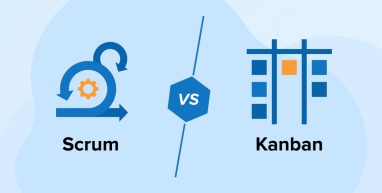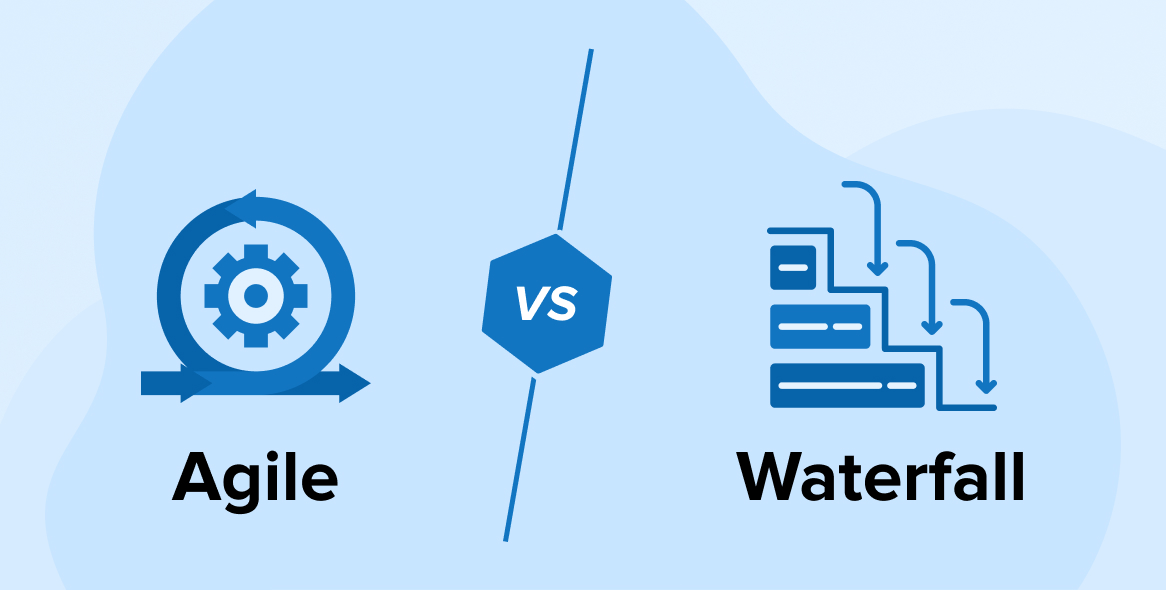
Businesses who have been closely working with project management tools would know that the names that dominate this industry are Agile,Scrum and Kanban methods. Until you have knowledge of these, it is not wise to use any of them in your project development methodology. With this blog we will explore more about Scrum vs Kanban and which you should choose.
Scrum and Kanban are two distinct project management methods that are frequently combined to provide a very efficient and smooth software development process. Whereas if we just talk about Scrum, then Scrum is a framework that enables scrum teams to handle complex adaptive challenges. Kanban is a workflow management strategy that helps Kanban teams to manage and enhance work across the development process.
1. What is Scrum?
Scrum is an agile process where complex tasks are divided into smaller parts and to be completed in sprints. Scrum has been a hot selling potato when it comes to project management and its strategies. Scrum has made a name in the software development industry with its development process. Scrum is able to handle complex projects easily with their agile practices. Scrum allows teams to focus on particular tasks for a short period of time. The entire process in Scrum is divided into sprints that can run anywhere from a day to four weeks, depending on the magnitude of the projects.
Businesses by now know that Scrum is fast-paced and provides continuous work. There is a fixed schedule predetermined start and completion dates. You also have restricted timelines, where the software development teams are compelled to break down large projects into smaller, more actionable operations.
Scrum sprints are composed of several stages, including sprint planning, sprint review, and sessions. Each phase is often monitored with daily Scrum meetings to discuss barriers, daily to-dos, or quick wins. The Scrum workability is based on three principles namely transparency, inspection and adaptability. The scrum process has a definite approach which goes something like this:
- The first comes Product backlog
- Sprint planning
- Sprint backlog
- Daily scrum
- Increment
- Sprint review
- Sprint retrospective
It works like when one sprint is completed only then the whole team will move to the next sprint . Similarly for other processes too, every member of the team will move from one section to another. Each sprint is dedicated to a special team and that team performs a single role.
1.1 Pros
Following are the pros of scrum:
- There is an established set of rules outlining everyone’s responsibilities and procedures.
- It is possible to break down massive tasks into smaller, more doable ones.
- Consistent delivery calendars help teams stay on task and give them an idea of what’s to come.
- The short duration of sprints promotes frequent testing and refinement.
- It is only through feedback loops that progress may be made indefinitely.
- Reduces overwhelming responsibilities to more digestible chunks of work.
- Rapid successes that may be achieved with little effort to boost morale.
- Everyone on the team can see what’s going on.
- Processes that are directed at achieving certain ends.
1.2 Cons
Following are the cons of scrum:
- Stagnation can occur when there is a lack of freedom of expression and rigid adherence to assigned responsibilities.
- Instruction for scrum masters/leaders and product owners is essential.
- A large number of meetings may become tedious for the group.
- Overly stiff sprinting might hamper midair changes.
- Every member of the team has to be on the same page during a sprint.
- Can’t keep up the pace if certain members of the squad are moving more slowly.
- The process of measuring, tracking, and managing sprints calls for substantial preparation and investment of time and money.
2. What is Kanban?
Kanban is a visual representation of the project management task. The term Kanban translates itself from its Japanese origin which means “visual signal”. This tool is well-known in the fields of custom software development and DevOps. Kanban emphasizes on the openness and straightforward communication with Kanban Boards. These kanban boards are used to reflect the status of projects that are ongoing currently. Kanban relies on continuous improvement and uses cumulative flow diagrams to understand the number of work items in each state.
The ability to set Work In Progress restrictions is a useful feature of Kanban. These constraints might draw attention to inefficient backlog in the workflow of the team. This enables the team leader to troubleshoot the issues before they become a problem. When we work with Kanban, there are no specified roles and responsibilities of the team. The Lead- Project manager asks the cross functional team to collaborate in every possible way. In this way each member will be involved in the planning process and it does not get overwhelmed for one person. When you adapt to Kanban as a methodology, you must practice these fundamental concepts like:
- The workflow visualization should be apt.
- The progress of the work should be limited.
- You must create specific process policies to manage the flow of work.
- You must set a customer feedback loop and work on it.
- Team Collaboration allows us to evolve and grow.
Kanban board is another essential part of this process which will be discussed in the later part of this blog. Now, we must try and understand the most competitive aspect of Kanban and that is Scrum.
2.1 Pros
Following are the pros of Kanban:
- Incredible adaptability and clarity of expression.
- Ability to respond freely to unforeseen events.
- The group accepts tasks when they become available.
- It’s less of a hassle to avoid piling on certain teammates.
- Reducing the amount of active jobs helps keep the cycle time steady.
- Facilitates constant development.
- You require fewer meetings and quicker iterations.
- It’s simple to observe the overall process and what activities are currently being worked on.
- Reduces the number of active tasks to maintain high quality.
- Controls how a project develops.
- Loops of communication are set up.
- Facilitates more interaction amongst team members.
- Modifiable, so that projects can shift focus as needed.
2.2 Cons
Following are the cons of Kanban:
- A lack of framework that can lead to digressions.
- Constant changes must be made to the board.
- Trying to make connections between tasks and long-term goals is difficult.
- Perhaps not applicable to interdisciplinary groups.
- A watchful eye is required to prevent the accumulation of out-of-date data.
- Inadequate time limits might cause delays.
- Without clear roles and duties, it’s hard for groups to work together effectively.
- Nothing is time-bound.
3. Differences Between Kanban vs Scrum
Here, let’s explore a detailed comparison between Kanban and Scrum.
3.1 Roles & Accountabilities
Scrum requires the following responsibilities to be introduced, or rather assigned:
- Product Owner: The Product Owner oversees the backlog and provides guidance to the development staff.
- Scrum Master: Project deadlines are set by the Scrum Master, and the team executes the tasks that were prioritized and prioritized during the Sprint planning session.
The beauty of Kanban is that it doesn’t need you to completely unroot your organization. Whilst these roles aren’t required by Kanban, there are two that you might want to consider implementing:
- Service Delivery Manager: By monitoring the board and stepping in to help when necessary, the Service Delivery Manager ensures that tasks are completed in a timely manner. The team member in this position is responsible for promoting a culture of continual development and offering suggestions for how the team might better itself.
- Service Request Manager: In most organizations, the Service Request Manager is an additional duty of the team leader. This stakeholder is in charge of ensuring that all processes adhere to established guidelines, that corporate governance is strengthened, and that the risk of any one employee is minimized.
3.2 Core Key Performance Indicators
The rate at which a backlog may be cleared out is used to determine the success of a project when using the Scrum process. The rate of output is tracked in Scrum by how quickly each sprint is completed. The success of successive sprints is dependent on the results of the previous sprint. For this reason, a project is successful if and only if all of its components come together without requiring any more time.
As compared to other methodologies, Kanban metrics are slightly altered. Success in Kanban is quantified by the length of the process’s cycles. In other words, this is the full amount of time that will be needed to finish the job. Both throughput and WIP are used as success indicators in Kanban.
3.3 Kanban Board vs Scrum Board
Kanban and Scrum both use visual management boards to track progress and make decisions. To be sure, there are significant distinctions between the two.
The product backlog may be thought of as an extension of the Scrum board. The team adds the agreed-upon number of tasks to the Scrum backlog on the board, and then does whatever they want as far as where they place the work they’re currently working on. By the end of the Sprint, everything must be marked as Done. The board must be reloaded after each cycle, logically.
Kanban boards, on the other hand, provide a constant visual representation of the team’s workflow. The end objective of this construction should be a long-lasting Kanban system. WIP restrictions should be clearly displayed on a genuine Kanban board. Improving delivery time requires regulating the flow of work into and out of the system.
3.4 Cadence
Like Scrum, Kanban is a “pull-forward” methodology, meaning that work on a new task is delayed until an existing one is complete. Scrum employs Sprints to split down the work, resulting in a far more predictable environment than Kanban “when it’s done” approach.
It means Kanban may have more or fewer deployments than a Scrum team with a standard two-week cadence, based on the scale of each project and the availability of development resources.
Bandwidth and scope are the deciding factors. For short-term tasks that may be finished in a day or two, Kanban is the way to go, while Scrum may put the work on hold until the remainder of the Sprint is finished. Scrum produces incremental work at the end of each Sprint, whereas Kanban could take months between releases on a large project.
To complete projects within Sprints, Scrum also calls for precise scope and estimating. As projects are not limited by a specific amount of time in Kanban, this is not required.
3.5 Change Philosophy
After the Sprint has been locked in Scrum, it cannot be changed. There will be no new features or removal of any existing ones. News about breaking events that occur late in a Sprint’s time period will have to be delayed until the following Sprint begins.
Kanban doesn’t have this restriction. Therefore, changes to scope, objectives, etc. may be made even as work is in progress.
3.6 Scrum vs Kanban Tools
Lastly, the tools that product teams utilize are a crucial distinction between the two approaches. Both Kanban and Scrum-based software tools exist today, both with the goal of making the development process more efficient.
In addition to an IDE, you may find yourself using popular Kanban tools like exploreMonday.com and Kanbanize, or Scrum-based tools like Zoho Sprints and Sprintly. It’s important to remember that both the Scrum and Kanban approaches may be used to manage project progress when using software like Jira and Trello.
4. Scrum Vs Kanban
Tabular comparison between Scrum vs Kanban helps you easily identify which can be the best fit for your software project.
| Parameters | Kanban | Scrum |
|---|---|---|
| Key metrics | The cycle time and the lead time are quite faster | This process is overall faster in almost all aspects. |
| Collaboration | Excellent | Meets the expectation and best for collaborating |
| Roles and Responsibilities | There is no specific role in Kanban. A project manager is the one who takes care of every small and big aspect of project management in Kanban. The team is already in close collaboration with each other and also raises a red flag in case the situation gets awry. | Each team member in the Scrum team has a clear role, with the Scrum master schedules the timelines.The Product Owner shows what goals and objectives needs to be achieved, and team members need to carry out that task. |
| Priority & Acceleration | This follows a methodical process which enables team members to “pull” new tasks only when the prior job has been completed. | Scrum works on “pull mechanism” which takes out a full batch of work in each iteration |
| Visual interpretation | It looks more like task based workflow and interactive visuals. | This works on sprint-based working for all types of tasks. |
| Primary Roles | Project Manager | Scrum Master |
| Development Cycle | Cycle time, or the time it takes to produce one whole element of a project from start to finish, is used to measure production. Sprints are used to calculate production velocity. | Each sprint is scheduled back-to-back and/or concurrently, so that the success of the previous sprint is dependent on the success of the next. |
5. Conclusion
To choose between Scrum versus Kanban approaches, consider your company requirements.
Both of these methods are excellent for monitoring projects and keeping developers on pace for completion. However, which you use will be determined by your demands, teams, and ambitions. Choose properly, and your development lifecycle will flourish.






This article explained very effectively about these two different strategies for implementing an agile development system. Both Scrum and Kanban are powerful, proven process tools that can improve your project management majorly. Kanban and Scrum each have their separate strengths. This article can guide you in selection between them.
Article explains the difference between these two agile methodology very well. I I think the article can explain more about kanban and scrum boards. But overall it is very informative.
There are several project management methods . Two most discussed methodologies are scrum and kanban. This article gives a complete introduction and difference between these two project management methodology. Article discusses different strategies for implementing an agile project management system. Kanban methodologies are continuous and more fluid, whereas scrum is based on short, structured work sprints.